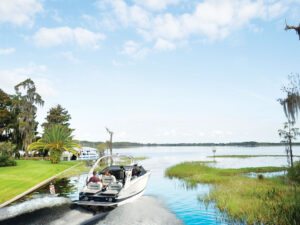In the waning days of winter, professional walleye angler Mark Martin faces a honeycombed sheaf of ice that lies between him and open water. Not to be outdone, however, Martin plans to run his aluminum Lund over the river and through the ice floes. Hard-core, yes, but a sure-fire way to get to hot fishing holes-if you do it with caution, care, and Martin’s expert wisdom. Here are his six rules for successfully navigating a winter wonderland.
Leave your fiberglass boat on its blocks. Fiberglass is more susceptible to damage from ice shards; aluminum, polyethylene, and roplene, on the other hand, glance off. “When you get thick ice-over 4″ or 5″-you don’t want to go too fast or it will cut through any kind of boat,” says Martin.
Even if you’ve got a fishing jones, only attack dark, deteriorating ice, which is called rotten ice, a U.S. Coast Guard classification for old, melting ice that’s in an advanced stage of disintegration. Rotten ice appears black because it’s saturated with water. Brash ice-the wreckage of ice fragments that often refreeze in a jumble overnight-is more difficult to negotiate. These chunks and shards will beat up your hull and prop.
To start breaking through rotten ice, garner a little speed to get the bow up and atop the ice. Then put your passengers in the bow for weight. This way, when you do motor at a slow pace, the heft in the bow will crunch the ice beneath. Maintain a steady speed-don’t back off the throttle or you’ll lose your momentum. If temperatures are below freezing, any spray on the bow will turn to ice. Your boat becomes top heavy, according to Wayne Kean of the U.S. Coast Guard in Sault Sainte Marie, Michigan, altering its center of gravity, and causing it to roll from side to side. What can you do about this? Bang it off with a hammer, or head home.
While navigating, skirt the edge of ice and take care not to enter the space between football field-size floes. If you get pinched, there might be no way to get out. Or you could get caught in a spot where the wind batters your boat against a reef or shore. What’s more, don’t set an anchor. If you do, a shifting chunk of ice could catch your rope and drag the boat under.
Back at the ramp, you’ll be hard pressed to call it a day if the launching pad is iced over. Bring an ice-melt application and cat litter or sand for traction. Of course, a shovel is not a bad idea either. Use it to scrape ice and snow that may hinder your tow vehicle’s progress.
By now, you’ve had so much fun boating and showing off to those scaredy cats that you’re ready to go again. But beware: Don’t detach your bowline the next time until your boat is fully in the water. If the bunks are iced, your boat could slip as you back down toward the water and crash-land on the concrete.









